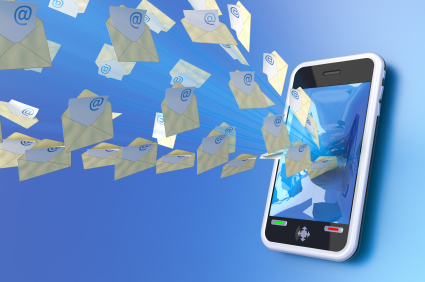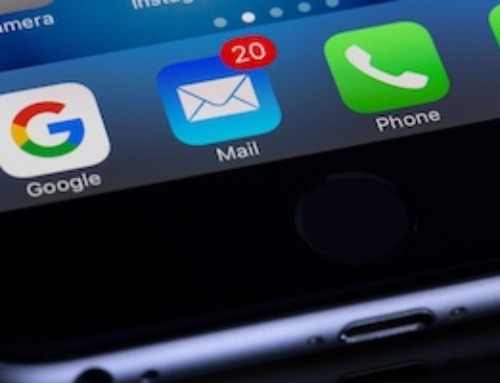 Just when marketers got the hang of effective email messaging, along came mobile devices. Now, more than a third of email recipients use their mobile devices to open or at least scan their email inbox (eMarketer). BlueHornet reports that 51.7% of U.S. email users are either “somewhat or extremely likely” to buy a product or service based on an email they have read on their mobile device. Experian recently reported that 45% of the 2012 holiday season’s emails were opened on mobile devices. This sharply-growing trend makes it necessary to optimize their emails for mobile devices.
Just when marketers got the hang of effective email messaging, along came mobile devices. Now, more than a third of email recipients use their mobile devices to open or at least scan their email inbox (eMarketer). BlueHornet reports that 51.7% of U.S. email users are either “somewhat or extremely likely” to buy a product or service based on an email they have read on their mobile device. Experian recently reported that 45% of the 2012 holiday season’s emails were opened on mobile devices. This sharply-growing trend makes it necessary to optimize their emails for mobile devices.
With that in mind, we’ve pulled together a list of 22 of the most important mobile marketing best practices for you to consider. Many of these best practices are less specific (such as optimum number of pixels, for example) but more about ways to approach mobile marketing from the get go.
- Develop a mobile mentality. Mobile email is more than a smaller version of your regular email. For example, your From name and subject line are going to work even harder in the small-screen environment of a mobile device. You’ll need to think small, but also differently.
- Know your audience. What percentage is using mobile devices and what kind? You’ll want to design for the majority of your users to have the optimal mobile experience. But first, you have to know who the majority is and what kind of phone they use.
- Keep in mind it’s not only mobile. Some people will start on a mobile device then move to a desktop. They do their email triage on the smartphone, saving the real interaction for later in front of their laptop or PC. Others will be on a tablet PC. When considering mobile marketing best practices, consider the other ways people will still interact with those emails.
- Shorten the subject line. If a shorter subject line won’t work, front load your subject line so the most important and attention getting words are first, as those might the only words the viewer sees on a tiny screen.
- Shorten the message…maybe. There’s a caveat here. This depends on the kind of message. Many people catch up on newsletters or other long emails on mobile devices when they find they have time to read when waiting. Sales messages, however, should probably be short and direct.
- Get to the point. Whether your message is a very short sales offer or a longer newsletter article, tell the recipient right away what to expect. This is where your preheader text can help, by essentially giving them a reason to keep scrolling down to the meat of your message, if it’s a longer message.
- Keep your main message in the left top corner with the call to action. That is where it is most likely to be seen.
- Consider your call to action: Should it change for mobile users? You’ll need a landing optimized for mobile if a landing page is needed. But perhaps the call to action is to literally call instead? Think through the environment of a mobile user, what they’ll likely respond to, and how they’d most likely do so.
- Design for fat fingers. Not everyone has fat fingers, of course, but you’ll want to make sure your buttons are easy to click on and text links have plenty of space around them to make them easier to touch. Even if fingers aren’t fat, users are often on the go—not sitting still—making big buttons and clear text links a big benefit for you.
- Think lean. Fingers might be fat?, but everything else must be lean. Think small file sizes, short sentences, and quick calls to action. A mobile device is small. So is the email that works in a mobile environment.
- Think height, not width. Many people start checking their email with their phone held vertically. Try not to make them have to turn it sideways to see your email at its best.
- Use larger font sizes. It’s a small screen. Try to make it easy to read. This means, once again, your text must be shorter and yet even more compelling because you will have less room for it.
- Design for one column. One column can work on a mobile screen and a desktop screen both.
- Keep images small. You need to keep images small not only because viewers are using a smaller screen but for download speeds too. The bigger the image, the longer it will take to load. An email designed for mobile should be around 50k in size, including text and images.
- Avoid style sheets, javascript, and complex coding. Like every other component of your mobile email, you want your coding lean and clean too.
- Team your designer and developer early in the process. Designers no longer have the luxury of handing over a clever concept to a coder. With the limitations of mobile, the one doing the design and the one writing the code must work together.
- Check the rendering on as many screen sizes as possible. Several services enable you to make sure your email is rendering appropriately on many different mobile screen types. Also see the BlueHornet whitepaper on designing for a wide variety of mobile screen sizes. Perhaps the most helpful illustration we’ve seen is the one of the different screen sizes imposed one on top of another. If nothing else, that will impress upon you the variety of sizes out there.
- Test, test, and test again. Test to get started and test to refine. Never stop testing. Ever.
- Remember the spam filters. They are still at work. Avoid using trigger words, and be sure your image and font sizes are within the limitations expected so as not to be flagged as spam.
- Optimize your landing pages for mobile too. Find tips for designing mobile-friendly landing pages here.
- Think beyond email. That mobile device is also a phone, making it easy for someone to call in response to your call to action. And it’s a browser, so they can go to a landing page. Plus it’s a camera, so inviting them to submit a photo might get an immediate response. They don’t think of their smartphones as solely email devices. Neither should we.
- Finally, remember the goal. Every kind of marketing has a goal–and a way to measure progress towards that goal. As you go through the process of adapting a mobile mindset and refining your use of mobile marketing best practices, be sure goals are clearly defined and metrics are determined and tracked.
Thoroughly optimizing for mobile is a critical component of successful mobile marketing even when it’s not the holiday season. BlueHornet reports about two-thirds of the U.S. audience use their mobile device to sort through email before reading it on their desktops, and almost 70% of them will delete a non-optimized mobile email. Less than 18% will save a non-optimized mobile email to view later on their desktop.
Adhere to these mobile marketing best practices, and your emails will be more likely to be engaging enough to be acted upon right from the smartphone or intriguing enough to make it past triage stage to the “big” screen of the desktop.



